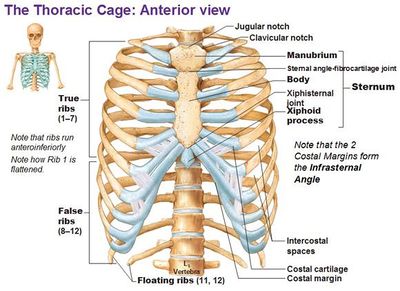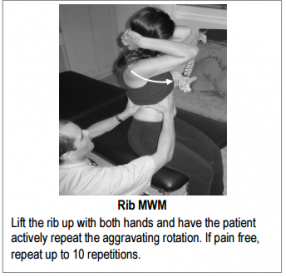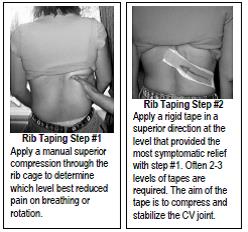Slipping Rib Syndrome
Original Editor - User:Jeroen Verwichte
Top Contributors - Tessa de Jongh, Laura Van Der Perren, Areeba Raja, Ine Wittevrongel, Kim Jackson, Gwen Wyns, Jeroen Verwichte, Lucinda hampton, Anouk Van den Bossche, Joao Costa, Claire Knott, Evan Thomas and Khloud Shreif
Introduction[edit | edit source]
Slipping rib syndrome occurs when the cartilage on a person’s lower ribs slips and moves, leading to pain in their chest or upper abdomen.
- Slipping rib syndrome goes by many names, including clicking rib, displaced ribs, rib tip syndrome, nerve nipping, painful rib syndrome, and interchondral subluxation, among others.
- The condition is slightly more common in women than men. It’s been reported in people as young as 12 years and as old as mid-80s, but it mostly affects middle-aged people.
- Overall, the syndrome is considered rare.[1]
Description[edit | edit source]
The slipping rib syndrome [2] is an infrequent cause of thoracic and upper abdominal intermittent pain and is thought to arise from hypermobility of the rib cartilage of the false and floating ribs (these are the most involved in this syndrome) [3]. This may cause disruption and allows the costal cartilage tips to subluxate and irritate the intercostal nerves [4]
Clinically Relevant Anatomy[edit | edit source]
The slipping rib syndrome is a condition affecting the false ribs.
There are 3 types of ribs:
- Ribs which are attached to the sternum by costosternal joints and ligaments (true ribs - 1-7th)
- Ribs which are connected to each other through a weaker cartilaginous or fibrous band (false ribs – 8-10th)
- Ribs which aren’t attached to the sternum or to each other (floating ribs – 11-12th)
The condition arises from hypermobility of the anterior ends of the false rib costal cartilages, which often leads to slipping of the affected rib under the superior adjacent rib. This slippage or movement can lead to an irritation of the intercostal nerve, strain of the intercostal muscles, sprain of the lower costal cartilage, or general inflammation in the affected area. Because of their weak connection, there is increased mobility and greater susceptibility to trauma [5][6]. Anterior rib hypermobility is also likely to cause problems in the posterior thoracic area, because it’s a closed system [5].
Epidemiology/Etiology[edit | edit source]
The ‘Slipping rib syndrome’
- Affects 20% to 40% of the general population during their lifetime [7][8][9].
- May occur at any age, more common in middle-aged women, and is a relatively uncommon, but recognized cause of recurrent lower chest and/or upper abdomen pain in adolescents [10][11][12].
- Less common in young children because of the flexibility of their chests [13][14][15][16][17].
It can be caused by:
- Hypermobility of the rib cartilage of the false and floating ribs (mostly involved in this syndrome), this allows the costal cartilage tips to subluxate and irritate the intercostal nerves. This hypermobility is thought to be the primary cause of slipping rib syndrome, and can be the result of thoracic or abdominal trauma (which can be neglected or forgotten) but this does not have to be [5][18][13].
- Constrained postures and previous abdominal surgery [5][19][20][21].
- People who play sports with higher risks for chest wall impacts (e.g. rugby, hockey, football players) [5].
- History of minor or significant trauma to the chest.
Characteristics/Clinical Presentation[edit | edit source]
Slipping rib syndrome is presented through the following characteristics [5][19][22][23]:
- Intense pain in the lower chest or upper abdomen above the costal margin, mostly at the height of the 8th, 9th and 10th ribs (false ribs)
- A tender spot on the costal margin
- Reproduction of the pain by pressing the tender spot or by external influences
- Signs and symptoms are usually unilateral, however there are also cases where patients reported bilateral pain[5][19][24].
Pain associated with slipping rib syndrome has distinct characteristics which can be used in identifying the syndrome:
- Usually described by patients as a intermittent sharp stabbing pain followed by a constant monotonous pain that may last from several hours to many weeks [13][25][5][26][27].
- Range of severity of pain varies from being a minor nuisance, moderately severe to interfering with activities of daily living [5][15][4].
- May also be reported to radiate from the costochondral area to the chest or to the same level in the back [5].
- Exacerbated by certain postures and movements: lying or turning in bed, rising from a chair, driving, stretching, reaching, lifting, bending, twisting the trunk, coughing, walking, or bearing loads [5][19][28][14][29][10][26][27].
- May affect sporting activities involving trunk movements and deep breathing, but in particular running, horseback riding [25], arm abduction, or swimming [4]. Pain may be severe enough to make patients stop playing sports.
- Visceral innervation converges at the same spinal cord levels as slipping ribs and intercostal nerves and this close association of the intercostal nerves and the sympathetic system may also cause a variety of somatic and visceral complaints, such as biliary or renal colic [30][13][25][4].
Differential Diagnosis[edit | edit source]
The differential diagnosis of slipping rib syndrome includes a variety of conditions
- Cholecystitis
- Esophagitis
- Gastric ulcers
- Stress fractures
- Muscle tears
- Pleuritic chest pain
- Bronchitis
- Asthma
- Costochondritis, or Tietze syndrome
- Appendicitis
- Heart conditions
- Bone metastases[1]
Diagnostic Procedures[edit | edit source]
Slipping rib syndrome is difficult to diagnose because the symptoms resemble other conditions. First take a medical history and ask about symptoms, including when they started and if anything makes them worse.One test that can aid in the diagnosis is the hooking maneuver:
- The hooking maneuver that helps diagnose slipping rib syndrome. To perform this test hooks your fingers under the rib margins and then move them upward and back - If this test is positive and causes the same discomfort, usually no need to do any additional tests such as an X-ray or MRI scan[1].
Outcome Measures[edit | edit source]
- The physiotherapist can reproduce chest pain by palpation of the ribs and chest wall [5].
- Hooking manoeuvre - Reproduce the symptoms. This is a relatively simple clinical test where the clinician places his or her fingers under the lower costal margin and pulls the hand in an anterior direction. Pain or clicking indicates a positive test [5][30][22][24]
- Patient-specific functional scale ( PSFS)[31].
- The Global rating of change (GROC) - To measure the patient’s subjective rate of improvement, the GROC has been stated to be reliable [32].
Examination[edit | edit source]
The physiotherapist looks for an association between certain movements or postures and pain intensity (signs and symptoms), determines if the patient has experienced recent trauma (not always present), constrained posture, or previous abdominal surgery and reproduces the symptoms (eg, pain, clicking) [5][20].
Signs and Symptoms[edit | edit source]
- Classically, the pain occurs in the upper abdomen or lower chest, in the abdominal wall and above the anterior costal margin.
- At that place the involved costal cartilage moves more freely than normal and the examiner can typically feel tenderness[22][20]. A painful click is sometimes felt over the tip of the involved costal cartilage with certain movements.
- Palpation - At physical examination, the most common finding in a case of slipping rib syndrome is the tenderness above the costal margin. The physiotherapist can reproduce chest pain by palpation [19][24][33][4].
- The Hooking manoeuvre - positive test
Medical Management[edit | edit source]
In some cases, slipping rib syndrome resolves on its own without treatment. Home treatment may include:
- Rest
- Avoiding strenuous activities
- Applying heat or ice to the affected area
- taking pain relieving medication like acetaminophen (Tylenol) or a nonsteroidal anti-inflammatory drug (NSAID), such as ibuprofen (Advil, Motrin IB) or naproxen (Aleve)
- Stretching and rotation exercises
If the pain continues despite taking a painkiller:
- A corticosteroid injection to help reduce the swelling
- An intercostal nerve block (an injection of an anesthetic in the intercostal nerve) to relieve pain
- Physical therapy intervention and management
If the condition persists or causes severe pain, surgery may be recommended. The procedure, known as costal cartilage excision, has been shown in clinical studies to be an effective treatment for slipping rib syndrome.[1]
Physical Therapy Management[edit | edit source]
Exercise[edit | edit source]
Exercises to Avoid:
- Because of the inherent instability of joints, exercises that put direct pressure on your chest should be avoided. Pushups or exercises that involve pitching or throwing motions increase risk. Sports that involve a potential for contact with other athletes such as football or basketball should be avoided until the condition resolves.
Early Exercise:
- In the beginning stage of recovery, segmental breathing is used to gain more mobility in the ribs.
- Pressure is applied, usually by a therapist, to where the ribs join the sternum. Client needs to breathe in and expand lungs while the pressure is applied. The pressure is moved from one segment to another while long slow breaths are drawn in to put pressure against the therapist's hand.
Expanding Exercises to increase mobility around the rib joints:
- Thoracic extension and flexion exercises can be used ie arching the back and allowing rib cage to expand, then bend forward and compress chest and ribs. Only perform to the limits of comfort.
- Seated rotation exercises can be done by sitting and turning chest and shoulders as far one side as you can ie like turning and looking over your shoulder, then turning to the other side. Use caution advice client to go slowly to avoid injury.
Specific for Slipping Rib Syndrome[edit | edit source]
- Recognition and education of the condition [5][34][22][20]. The patient can be taught to avoid movements and positions that provoke the pain without creating asymmetric overcharge in other regions of the body
- Reassurance of the benign nature of the disease combined with explanation and advice concerning postural avoidance [34]
- Using heat (hot packs) or cold (ice), ultrasound and NSAID to the affected rib might be of value in relieving the pain for intermittent periods [5][24][4].
- Manual therapy: manipulation of the costovertebral joint and electric stimulation can help manage the pain, but probably no long term relief [5].
- Taping of ribs can possibly provide some temporary relief.To decide on the location and direction of taping, apply a manual superior compression force through the postero-lateral aspect of the rib cage. Now ask the patient to take in a deep breath or rotate. If the patient notes a significant improvement in symptoms, then apply the tape at that level [35].
- Rib mobilization with movement (MWM) as proposed by Brian Mulligan. The range of motion and pain level are evaluated. A cranial glide is applied over the lateral aspect of the rib above the painful region. While sustaining this rib elevation (unloading), the patient is asked to rotate again while ROM and pain are once again evaluated. If there is no change, the technique is repeated on a rib above or below. If MWM on a rib at a specific level is found to reduce or eliminate the pain, it is repeated 10 times [35].
- A home program of self MWM may be provided. Instruction: “lift the rib up with the web space of one hand and actively rotate towards the painful direction, repeat as often as necessary”. The goal is to move the irritated costovertebral joint without pain as often as possible to reduce both the protective muscle spasm and the local inflammation [35]
Clinical Bottom Line[edit | edit source]
- The Slipping rib syndrome is an often under diagnosed disease for which sometimes comprehensive diagnostic evaluation is performed.
- Knowledge of the slipping rib syndrome can lead to quick and simple diagnosis and prevent months or years of chronic complaints.
- The impingement can cause severe constant pain and a slipping sensation provoked by several movements.
- It can also lead to an irritation of the intercostal nerve or problems to structures in that area.
- Knowledge of the syndrome is important; it can lead to quick and simple diagnosis.
References[edit | edit source]
- ↑ 1.0 1.1 1.2 1.3 Healthline Slipping Rib Syndrome Available from:https://www.healthline.com/health/slipping-rib-syndrome#symptoms (last accessed 6.5.2020)
- ↑ Cyriax E, et al., On various conditions that may simulate the referred pains of visceral disease and a consideration of these from the point of view of cause and effect, Practitioner, 1919
- ↑ [/www.sciencedirect.com.ezproxy.vub.ac.be%3A2048/science/article/pii/S1526054216300094 Nelson L Turcios] et al.; Slipping Rib Syndrome: An elusive diagnosis; [/www.sciencedirect.com.ezproxy.vub.ac.be%3A2048/science/journal/15260542 Paediatric Respiratory Reviews] [/www.sciencedirect.com.ezproxy.vub.ac.be%3A2048/science/journal/15260542/22/supp/C Volume 22], March 2017, Pages 44–46
- ↑ 4.0 4.1 4.2 4.3 4.4 4.5 Saltzman D.A. et al. The slipping rib syndrome in children. Pediatric Anesthesia. Volume 11, Issue 6, November 2001, Pages 740–743 (LoE 4)
- ↑ 5.00 5.01 5.02 5.03 5.04 5.05 5.06 5.07 5.08 5.09 5.10 5.11 5.12 5.13 5.14 5.15 5.16 Udermann B.E. et al.; Slipping Rib Syndrome in a Collegiate Swimmer: A Case Report; J Athl Train, 2005 (LoE 3B)
- ↑ McBeath A.A. et al.; The rib-tip syndrome; J. Bone Joint Surg. Am., 57 (1975), pp. 795–797 (LoE 3A)
- ↑ Nilsson S et al.; Chest pain and ischaemic heart disease in primary care; Br J Gen Pract 2003; 53: 378–82 (LoE 1A)
- ↑ BÖSNER S. et al. Chest wall syndrome in primary care patients with chest pain: presentation, associated features and diagnosis. Family practice, 2010, 27.4: 363-369. (LoE 5)
- ↑ Verdon F. et al.; Chest pain in daily practice: occurrence, causes and management; Swiss Med Wkly 2008 (LoE 1B)
- ↑ 10.0 10.1 Porter G.E. et al.; Slipping rib syndrome: an infrequently recognized entity in children: a report of three cases and review of the literature; Pediatrics, 76 (1985), pp. 810–813 (LoE 3A)
- ↑ Lum-Hee N. et al.; Slipping rib syndrome: an overlooked cause of chest and abdominal pain; Int. J. Clin. Pract., 51 (4) (1997), pp. 252–253 (LoE 4)
- ↑ Turcios N.L. et al.; Slipping rib syndrome in an adolescent: an elusive diagnosis; Clin. Pediatr., 52 (9) (2012), pp. 879–881 (LoE 2B)
- ↑ 13.0 13.1 13.2 13.3 Cranfield K.A.W. et al.; The twelfth rib syndrome;Journal of Pain and Symptom Management, 1997. (LoE 3B)
- ↑ 14.0 14.1 Van Delft E.A.K. et al.; The Slipping Rib Syndrome: A case report; International Journal of Surgery Case Reports, 2016. (LoE 4)
- ↑ 15.0 15.1 Veeram S.R. et al.; Chest Pain in Children and Adolescents; Pediatrics in Review, 2013. (LoE 4)
- ↑ Kumar R. et al.; The painful rib syndrome; Indian Journal of Anaesthesia, 2013 (LoE 4)
- ↑ Spence E.K. et al.;The slipping rib syndrome; Arch. Surg., 18 (1983), pp. 1330–1332 (LoE 1A)
- ↑ Malghem J. et al.; Costal Cartilage Fractures as Revealed on CT and Sonography; American Journal of Roentgenology, 2001 (LoE 2B)
- ↑ 19.0 19.1 19.2 19.3 19.4 Scott E.M. et al.; Painful rib syndrome: a review of 76 cases; Gut 1993 July (LoE 3A)
- ↑ 20.0 20.1 20.2 20.3 Meuwly J. et al.; Slipping Rib Syndrome A Place for Sonography in the Diagnosis of a Frequently Overlooked Cause of Abdominal or Low Thoracic Pain; Journal of ultrasound in medicine, 2002. (LoE 4)
- ↑ Barki J. et al.; Painful rib syndrome (or Cyriax syndrome): Study of 100 patients; Europe PMC, 1996 (LoE 3A)
- ↑ 22.0 22.1 22.2 22.3 Adel G. et al.; Musculoskeletal chest wall pain; Can Med Assoc J, 1985 (LoE 5)
- ↑ Hudes K. et al.; Low-tech rehabilitation and management of a 64 year old male patient with acute idiopathic onset of costochondritis; J Can Chiropr Assoc. Dec 2008, 52(4):224-8. (LoE 4)
- ↑ 24.0 24.1 24.2 24.3 Keoghane S.R. et al.; Twelfth rib syndrome: a forgotten cause of flank pain; BJUI International, 2008 (LoE 5)
- ↑ 25.0 25.1 25.2 Mooney D.P. et al.; Slipping rib syndrome in childhood; J. Pediatr. Surg., 32 (7) (1997), pp. 1081–1082 (LoE 3B)
- ↑ 26.0 26.1 Arroyo JF, Vine R, Reynaud C, Michel JP. Slipping rib syndrome: don’t be fooled. Geriatrics. 1995;50:46–49. (LoE 3A)
- ↑ 27.0 27.1 Copeland GP, Machin DG, Shennan JM. Surgical treatment of the ‘‘slipping rib syndrome.’’ Br J Surg. 1984;71:522–523. (LoE 1A)
- ↑ Machin D.G. et al.; Twelfth rib syndrome: a differential diagnosis of loin pain; British Medical Journal, 1983 (LoE 4)
- ↑ Mynors J.M. et al.; Clicking rib; Lancet, 1 (1973), p. 674 (LoE 1B)
- ↑ 30.0 30.1 Bass J. et al.; Slipping Rib Syndrome; Journal of the National Medical Association, 1979;71(9):863-865. (LoE 4)
- ↑ Richard B. Westrick et al.; EVALUATION AND TREATMENT OF MUSCULOSKELETAL CHEST WALL PAIN IN A MILITARY ATHLETE; Int J Sports Phys Ther. 2012 June; 7(3): 323–332 (LoE 4)
- ↑ Proulx A. M. et al.; Costochondritis: Diagnosis and treatment; American Family Physician; 80(6), 617–620. doi:10.1016/S0015-1882(09)70196; 2009 (LoE 5)
- ↑ Ronga A. et al.; Development and validation of a clinical prediction rule for chest wall syndrome in primary care; BiomedCentral, 2012. (LoE 2B)
- ↑ 34.0 34.1 Gregory P.L. et al.; Musculoskeletal problems of the chest wall in athletes; Sports Med. 2002 (LoE 3A)
- ↑ 35.0 35.1 35.2 Bahram J. et al.; Ribs don’t sublux, ribs don’t “go out” … so what’s going on?; Advanced Physical Therapy Education Institute, 2015 (LoE: 4)
- ↑ Rib MWM. [Accessed 16 May 2020]











